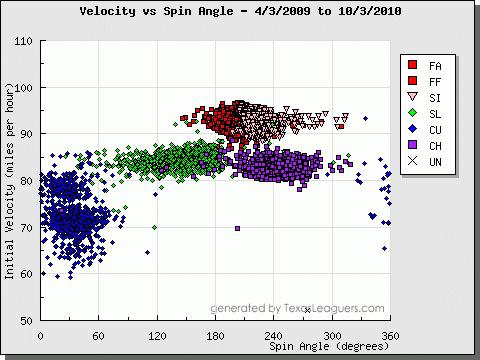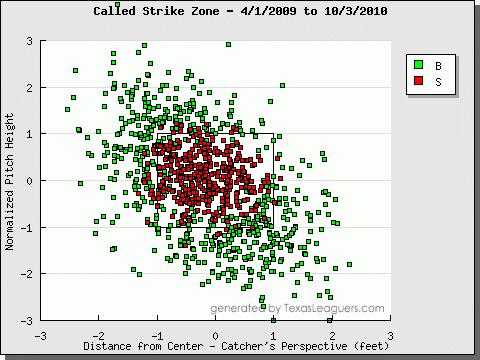In all likelihood, Bert Blyleven will be inducted into the Baseball Hall of Fame next week. This marks Blyleven's 14th year on the ballot, which places his year of retirement at 1992. I have never, not once in my life, watched Bert Blyleven pitch, but I sure have read a lot about the man. Blyleven was a workhorse who amassed piles of strikeouts, shutouts, and wins. His HOF candidacy over the years has taken a roller coaster ride. Detractors point to his merely decent winning percentage and lack of cultural impact, whereas his supporters make note of Byleven's sterling postseason record and legendary curveball.
What current pitcher is most similar to Bert Blyleven? The nominees:
When you think of big curveballs nowadays, you think of Adam Wainwright. Over the last two years, Wainwright's curveball has been worth 45.7 runs according to FanGraphs, 20 runs better than the runner-up. Wainwright doesn't shy away from the pitch, throwing it a quarter of the time, the third-highest rate in the Majors. However, nobody can match the 40% rate Blyleven estimated that he threw in 1978. Blyleven was known for freezing batters with his curve, and Wainwright had at least one such famous moment. Both Wainwright and Blyleven threw their curveballs in unusual fashions. According to pitch grip expert Mike Fast, Wainwright's curve "is not quite a standard curveball grip in that his index finger is completely off the ball. Most pitchers lay it down alongside the middle finger on the ball." Blyleven, on the other hand, said that he "holds both his fastball and curveball across the seams." Blyleven recalled Sandy Koufax and Bob Feller pitching the same way, but at the time knew of no one else who did. I asked Mike Fast, and he is unaware of any current pitcher who exhibits this trait. Here's an image of a potential Blyleven curve.
Like Blyleven, Oswalt has been a durable pitcher, averaging 200 innings per year in his career. According to Blyleven's manager Ray Miller, Blyleven was able to hold up year after year thanks to a smooth delivery with "a lot of leg drive," and Blyleven himself said "my durability as a pitcher comes from my legs more than my arm." 60ft6in's Sven Jenkins describes Roy Oswalt as "the ultimate 'drop and drive' pitcher.' He uses his legs to get the most out of his slight frame."
Blyleven's curve was the subject of Baseball Digest stories in 1978 and then again in 1989. Both times, he described two different variations of his curve. One, a "roundhouse curve" had a big, lazy break. The other, his "overhand drop" became his specialty. Several current pitchers throw multiple curves, including Bronson Arroyo, who can add and subtract from all of his pitches, and Chad Billingsley, who mixes in up to seven distinct pitch types. And Mike Mussina would have been a great Blyleven comp, given their durability, their propensity to throw breaking pitches, throw breaking pitches for strikes, and willingness to pitch to both sides of the plate. But Moose retired, so I'm not including him as a nominee. Instead, I think Roy Oswalt's array of curveballs aligns best with Blyleven's description. Oswalt has a standard overhand curve that clocks in the high 70s, but Oswalt has explained that he also throws a slower curveball by choking the ball deep into his hand. Jenkins notes that Oswalt can vary the velocity on his signature 12-to-6 curve from the upper 70s to down into the 60s. On the left side of this image, you can see the distinct clusters forming Oswalt's curveballs. You can also see that the ball's axis of rotation approaches zero degrees at times.

Verlander throws a monster breaking ball. He is generally around the plate with his curve, too. Verlander's curve baffles hitters, but more importantly, it fools umpires as well. In one famous incident, Blyleven got so fed up with an umpire's refusal to call his curveball for strikes that he began to throw batting-practice fastballs, afterward saying, "if he's not going to call my curveball for strikes, then I'm just going to throw my fastball down the middle." Verlander had a notable argument with an umpire this year for "not getting the strike call on back-to-back breaking balls around the inside corner."
Here is the called strike zone for Verlander's curve over the last two years.

I guess the only way you can tell whether the zone is fair or not is by counting the number of green points inside the strike zone box and the red points outside it. The method I used in determining that Verlander's curveball was the most umpire-unfriendly in baseball controlled for batter handedness, batter height, and pitch movement. It showed that Verlander has been screwed out of about 50 strikes, 20 more than anyone else. By comparison, here's the curveball strike zone for Javy Vazquez, to whom umpires have been more generous. Pay particular attention to the area down and away from RHBs.
Ranking in terms of "stuff," Stephen Strasburg and a plethora of relievers boast the nastiest curveballs. But for starters with some degree of longevity, Burnett's is the hardest to hit. Burnett's curveball induces whiffs on 45% of swings, an obscene number. That's partially because he's so wild, throwing his curve in the zone under a third of the time. Blyleven and Burnett had similar philosophies about where to throw their curves, if not similar execution. Blyleven said that he "keeps the ball low and away to a righty," which appears to be Burnett's intention. Against lefties, Blyleven would try to "nick the outside corner" or "break it low and in." Again, this fits a visualization of Burnett's curve vs. LHBs. The problem is that where Blyleven threw strikes, Burnett throws wild pitches. Like Blyleven, Burnett is almost exclusively a two-pitch fastball/curveball pitcher, at times tinkering with a show-me change. Blyleven said that he threw his fastball in the low 90s and his curveball in the mid 80s. Burnett comes as close as it gets to fitting that profile.
Burnett also gets a nod for reportedly loosening up the Yankee clubhouse. His trademark is the cream pie, while Blyleven was a master at the hot foot.
Carpenter, like Wainwright, throws a whole lot of curveballs, and he throws them well. Carp and Waino throw with similar velocity, movement, and release points. Few can spin the ball like these two. What sets Carpenter apart is that, like Blyleven, his fastball might be his better pitch. Wainwright's curveball has dominated baseball over the last two years, but Carpenter is the only pitcher in baseball with a fastball ranking in the top ten in terms of run value in addition to his top ten curveball. Blyleven said that, "my fastball was my best pitch, because it set up my curve. The control of your fastball is the key to success for any pitcher -- and not being afraid to pitch hard inside." Just last week, he said on the Jonah Keri Podcast, "my curveball was a very good pitch for me, but it's my fastball that set it up. Establishing the fastball on both sides of the plate set up my curveball." Carpenter pitches to both sides of the plate with his fastball. Pretty much anywhere so long as it's a strike. And when he is able to set up his curveball with a fastball, nobody has a chance. Carpenter's curve is on average 1.5 runs per 100 pitches above average, but when preceded by his fastball, it's 3.5 runs above average.
I submitted my ballot to Rich Lederer, who was given the final say on whom to elect for the Bert Blyleven Award:
-----
Jeremy sent an email a few days ago informing me that he wanted to "compare Blyleven to modern-day pitchers using PITCHf/x data for people like me, who never got to see Blyleven pitch." Here is my return email to Jeremy.
I believe Roy Oswalt, Adam Wainwright, Mike Mussina, Josh Beckett, and Chris Carpenter are good comps. Those would be my top five. All of these pitchers make sense if you think in terms of fastball velocity, wCB and wCB/C, WHIP, and K/BB.Blyleven was a fastball/curveball pitcher. He threw an occasional changeup but it wasn't a significant part of his repertoire. His roundhouse was the so-called "slow curve" and the overhand drop the "12-to-6 hammer curve" that was his out pitch. With no public postings of radar-gun readings in those days to measure his fastball, my guess is that Blyleven threw a low-90s heater with the ability to dial it up to the mid-90s on occasion during the first half of his career. He definitely threw hard but his fastball more or less set up his curve. He could throw strikes with his fastball and curveball on both sides of the plate and at any point in the count.
Bert was also a workhorse. He threw more than 270 innings in eight different seasons. Of note, the 293.2 innings he pitched in 1985 has not been surpassed in the past 25 years. Leading the AL in home runs allowed in 1986 and 1987 had as much to do with ranking first and fourth, respectively, in innings pitched as it did with being around the plate a lot and hanging a few curveballs. However, for Blyleven's career, he was right at the MLB average for allowing homers (2.1% vs. 2.0%) and, in fact, gave up fewer HR/9 than a composite of his eight most similar HOF pitchers.
As it relates to his comps, Oswalt's fastball has averaged 93.1 mph during his career. Wainwright 90.6. Mussina 88.3 since 2002, probably more like 90ish in the earlier part of his career. Beckett 94. Carpenter 91.5 since 2002. The latter took much longer to develop and has missed more time to injuries than Blyleven. I think these are all good comps though. 90-94 mph fastballs with outstanding curveballs, excellent control and command, and somewhat similar K and BB rates.
I didn't realize I had final say on the Bert Blyleven Award (singular) until Jeremy returned with his nominations. The truth of the matter is that I believe a composite of Oswalt and Wainwright would be one heck of a match. A righthanded starting pitcher with a 92 mph fastball and a hellacious curveball with outstanding control and the ability to miss bats.
The winner? Roy Wainwright. Or is it Adam Oswalt? OK, make it Roy Oswright. Or even Adam Wainwalt. Yeah, it's one of those guys.
For what it's worth, here is a statistical comparison between Blyleven's career through his 32-year-old season and Oswalt:

Similarly, here is a statistical comparison between Blyleven's career through his 28-year-old season and Wainwright:

-----
This marks my final piece as a regular contributor to Baseball Analysts. I'm no longer a student, which means that I now have to make my way out in the real world--the one with all the hard knocks. I'm much obliged to Rich for giving me a writing platform and always providing thoughtful comments on my work. Thanks to my fellow authors at Baseball Analysts for giving it 100% and no more because they knew doing so would be mathematically impossible. And thanks to the readers, especially to those who were generous enough to offer criticism. Catchphrase.
- Subscribe to Baseball Analysts using Google Reader
- Get started using Google Reader to easily keep up with all your favorite sites
